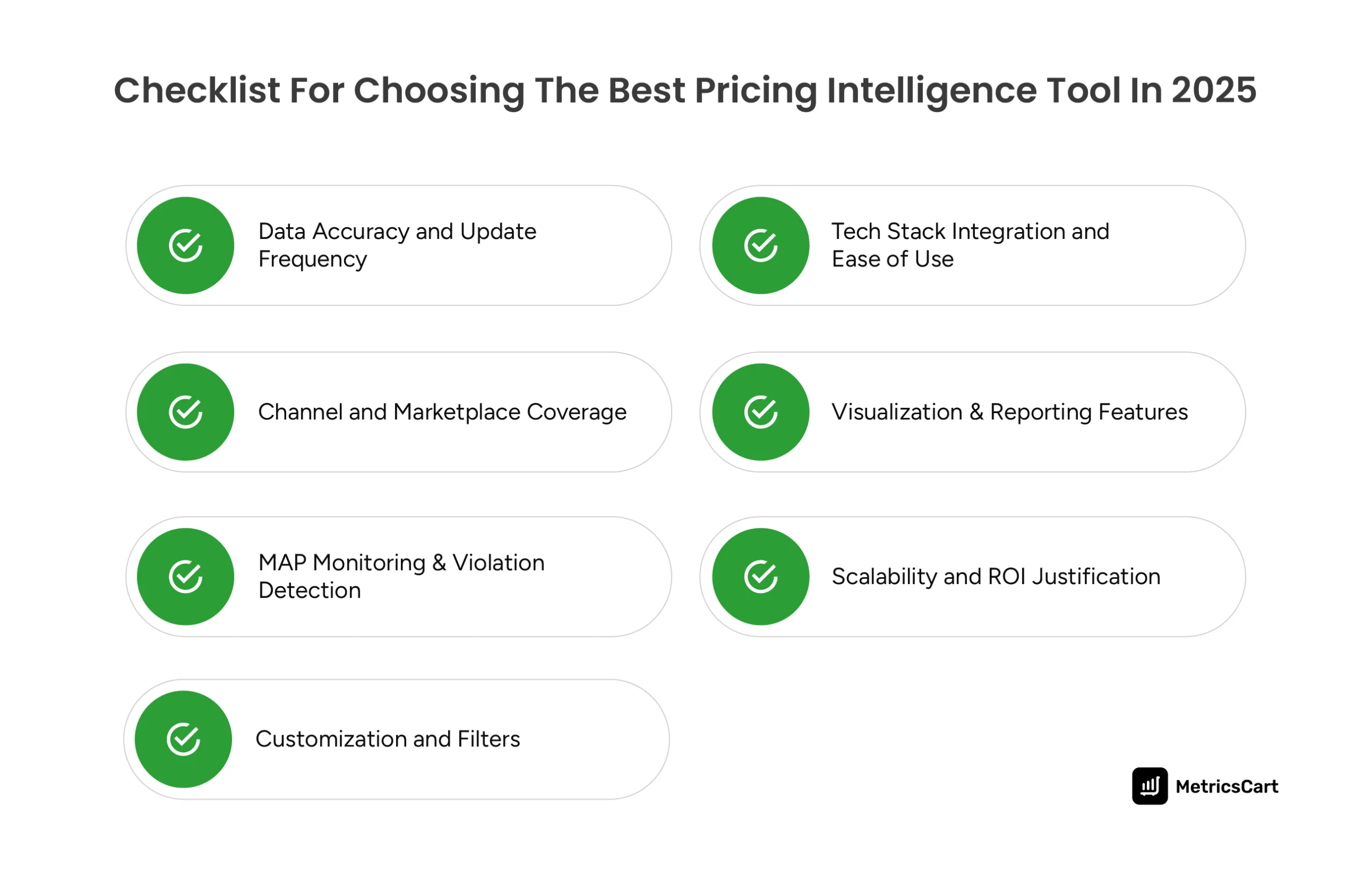Pricing decisions can make or break your brand’s profitability. With millions of listings constantly adjusting prices across Amazon, Walmart, and other major marketplaces, staying reactive isn’t enough.
You need a proactive system, a pricing intelligence tool that delivers real-time insights and actionable data. According to Deloitte, 63% of consumers will switch retailers for better prices, even if it means waiting longer. That’s not a margin you can afford to ignore.
So, how do you pick the best price intelligence software for e-commerce in 2025? This guide breaks down what to look for, the key benefits to expect, and why MetricsCart ticks all the boxes.
What Is A Pricing Intelligence Tool?
Price intelligence automates the tracking, analysis, and optimization of prices across competitors, marketplaces, and your own channels. It aggregates real-time data, detects pricing patterns, monitors competitive moves, and simulates pricing outcomes.
It provides actionable insights that enable brands to build intelligent pricing strategies, manage margin pressures, and respond to volatile market dynamics with speed and precision.
Pricing intelligence is not just about collecting data; it’s about making sense of it. Whether you’re tracking competitor pricing, MAP violations, or promotional shifts, pricing intelligence software keeps your team proactive rather than reactive.
READ MORE | Curious how real-time monitoring protects your pricing? Check out Competitor Price Monitoring Solution for E-Commerce.
Benefits of Price Intelligence Software for E-Commerce
Before you choose a tool, it’s important to understand the value it should deliver. The best pricing intelligence tool will drive measurable business outcomes, not just dashboards.
Optimize Profit Margins Without Losing Sales
Dynamic pricing isn’t about slashing prices; it’s about precision. Pricing intelligence tool allows you to set optimized price points for different channels and customer segments based on real-time and historical data. It helps identify the sweet spot where you maximize profits without driving away customers.
Improve Competitor Visibility and Price Integrity
Price intelligence gives you a clear picture of how your competitors are pricing, discounting, and promoting similar products. This helps you position your listings accurately, track new entrants, monitor undercutting tactics and price erosion, and respond to aggressive pricing moves without guesswork.
Enhance Promotional Strategy with Historical Insights
Price history tells a story and helps predict the future. The best price monitoring tools archive past promotional cycles, allowing you to understand which discount depths delivered lift, which promotional pricing strategies flopped, and how competitors reacted. This lets you align pricing with seasonality, avoid price wars that erode margins, and avoid discount fatigue.
Automate Manual Monitoring & Reduce Operational Overhead
A pricing intelligence tool automates the grunt work: scraping prices, matching SKUs, identifying anomalies, pushing critical alerts, and monitoring MAP violations. This automation frees up analysts and brand managers to focus on strategy rather than spreadsheets, reducing monitoring time by up to 70% and increasing pricing responsiveness.

How To Choose The Best Pricing Intelligence Tool in 2025?
Choosing a pricing intelligence tool isn’t about picking the most popular software; it’s about finding one that fits your e-commerce operation like a glove. The right tool should match your scale, adapt to your workflows, and produce ROI, not just reports.
Here’s your 2025 checklist for how to choose a pricing analytics tool in 2025

Data Accuracy and Update Frequency
Accurate data is the foundation of any pricing decision. Your tool must pull live, validated pricing data. Look for tools that use advanced matching algorithms to reduce SKU mismatches, handle multi-pack variations, and filter out irrelevant listings.
The best pricing intelligence tools also flag discrepancies and include confidence scores or audit trails for each price point gathered. If the tool pulls stale or incorrect data, your entire pricing strategy falls apart.
Channel and Marketplace Coverage
Your brand may sell on Amazon today and also on Walmart tomorrow. The pricing intelligence tool you choose must cover all relevant marketplaces, retailer websites, and even niche DTC platforms.
Strong crawl infrastructure and flexible URL onboarding are essential for full coverage. Does the tool cover all the marketplaces and retailers where your brand is present? Amazon, Walmart, Target, DTC, regional chains; the best software has wide and deep coverage with reliable crawl capabilities.
MAP Monitoring & Violation Detection
MAP violations quickly erode brand equity. Top-tier price intelligence software for e-commerce detects unauthorized price drops across sellers, flags repeat offenders, and logs each violation with timestamped screenshots or proof links.
Even better, it should offer automated enforcement workflows, like customizable warning notices or alerts, saving hours of manual policing. MAP enforcement is non-negotiable. The right tool flags MAP violations in real time, identifies repeat offenders, and provides documented proof to send to violators. This protects brand equity and maintains a healthy distribution network.
Customization and Filters
Make sure the pricing intelligence tool you choose allows for fully customizable reports and dashboards that fit your team’s specific KPIs. It should support flexible pricing rules, such as competitive undercutting thresholds, MAP-specific flags, or tiered strategies across geographies.
Additionally, look for tools that let you zero in on specific product categories, regional pricing zones, or channel-specific promotions. This ensures your team is in sync with the most relevant pricing signals, not noise.
Tech Stack Integration and Ease of Use
Whether you’re using an ERP system, e-commerce platform like Shopify or BigCommerce, or inventory and analytics tools, the pricing solution should connect without friction. Many tools today offer API integrations, which make it easier to sync data automatically and minimize duplication of effort.
A complex pricing intelligence tool can quickly become a bottleneck, stalling your pricing decisions rather than streamlining them. The tool should offer a clean, intuitive interface that allows quick extraction of insights. Before choosing a tool, ask for a live demo or trial version. Use it to assess how user-friendly the interface is, how well it fits into your workflows, and whether it’s simple for your team to adopt.
Visualization & Reporting Features
A great pricing intelligence tool doesn’t just gather data; it helps you understand it clearly and act on it confidently. Effective visualization and reporting features turn complex pricing patterns into simple, actionable insights.
Look for tools that offer dynamic dashboards with clear trend graphs, side-by-side competitor comparisons, and visual cues for price gaps or violations. The ability to generate and customize reports on demand is key. It’s a bonus if the tool includes predictive analytics to help forecast pricing trends and optimize upcoming promotions. This makes your reporting not just reactive but strategic.
Scalability and ROI Justification
The best pricing intelligence tool should grow with your business, not slow it down. Whether you’re managing 500 SKUs or scaling to 50,000, the solution should handle increased volume without performance dips or unexpected cost spikes.
It must justify the cost with real outcomes. The best tools provide clear ROI. Evaluate the price tag in context. What’s the time saved? How many violations were caught? What margin uplift was delivered? Transparent pricing tiers and no hidden fees make budgeting easier for brand teams and procurement alike.
READ MORE | Looking to safeguard your brand’s pricing strategy? Check out this guide on How to Choose MAP Monitoring Software for Your Business.
Why MetricsCart Is The Best Pricing Intelligence Tool
MetricsCart’s pricing intelligence tool is a complete solution built for modern e-commerce complexity. It combines real-time price tracking, competitor benchmarking, promotional analytics, and MAP monitoring and enforcement into one unified platform.
With MetricsCart, you can:
- Monitor pricing across marketplaces like Amazon, Walmart, and DTC channels with high-frequency data updates.
- Track historical pricing trends to inform promotional strategies and campaign timing.
- Benchmark against competitors and detect pricing gaps instantly.
- Ensure MAP compliance with automated violator detection, evidence collection, and tiered enforcement.
- Customize dashboards, reports, and alerts to suit your team’s workflow.
- Easily integrate with your existing tech stack for seamless adoption.
Whether you’re launching a new SKU, defending the buy box, or adjusting pricing across global markets, MetricsCart equips your team with the insights and tools to act quickly and profitably. It’s scalable, reliable, and focused on helping you make pricing a growth lever, not a guessing game.
Final Thoughts
Choosing the best pricing intelligence tool in 2025 isn’t just about features; it’s about fit. In a marketplace where pricing agility, MAP compliance, and margin protection are daily challenges, brands need more than raw data. They need a solution that delivers clarity, speed, and strategy.
The right tool should integrate seamlessly, offer customizable reporting, track market shifts in real-time, and empower each team, from pricing analysts to brand managers, to make smarter, faster decisions.
MetricsCart checks all these boxes. It’s built for the complexities of modern e-commerce and delivers insights that translate directly into revenue protection and growth. Book a demo today to explore MetricsCart and take control of your pricing.
Ready To Scale Your Brand and Drive Results? Unlock Your E-Commerce Potential Today!
FAQs
They are software platforms that monitor and analyze prices across multiple channels to help brands make informed pricing decisions.
Start by analyzing market data, customer willingness to pay, competitor pricing, and internal margin goals; then test and optimize.
It’s a dynamic pricing strategy powered by real-time data, competitor behavior, and demand patterns to maximize profitability.
Setting prices based on what competitors charge, adjusted for value proposition, brand positioning, and market share goals.
Retail pricing intelligence involves collecting and analyzing retail pricing data to optimize pricing, promotions, and competitive positioning.




